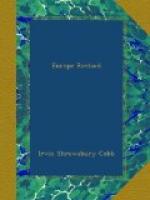Our guide was pleased to introduce us to the late Mr. Charles Pease, as done in paraffin, with creped hair and bright, shiny glass eyes. Mr. Pease was undoubtedly England’s most fashionable murderer of the past century and his name is imperishably enshrined in the British affections. The guide spoke of his life and works with deep and sincere feeling. He also appeared to derive unfeigned pleasure from describing the accomplishments of another murderer, only slightly less famous than the late Mr. Pease. It seemed that this murderer, after slaying his victim, set to dismembering the body and boiling it. They boil nearly everything in England. But the police broke in on him and interrupted the job.
Our attention was directed to a large chart showing the form of the victim, the boiled portions being outlined in red and the unboiled portions in black. Considered as a murderer solely this particular murderer may have been deserving of his fame; but when it came to boiling, that was another matter. He showed poor judgment there. It all goes to show that a man should stick to his own trade and not try to follow two or more widely dissimilar callings at the same time. Sooner or later he is bound to slip up.
We found Stratford-upon-Avon to be the one town in England where guides are really abundant. There are as many guides in Stratford as there are historic spots. I started to say that there is at least one guide in Stratford for every American who goes there; but that would be stretching real facts, because nearly every American who goes to England manages to spend at least a day in Stratford, it being a spot very dear to his heart. The very name of it is associated with two of the most conspicuous figures in our literature. I refer first to Andrew Carnegie; second to William Shakspere. Shakspere, who wrote the books, was born here; but Carnegie, who built the libraries in which to keep the books, and who has done some writing himself, provided money for preserving and perpetuating the relics.
We met a guide in the ancient schoolhouse where the Bard—I am speaking now of William, not of Andrew—acquired the rudiments of his education; and on duty at the old village church was another guide, who for a price showed us the identical gravestone bearing the identical inscription which, reproduced in a design of burnt wood, is to-day to be found on the walls of every American household, however humble, whose members are wishful of imparting an artistic and literary atmosphere to their home. A third guide greeted us warmly when we drove to the cottage, a mile or two from the town, where the Hathaway family lived. Here we saw the high-backed settle on which Shakspere sat, night after night, wooing Anne Hathaway. I myself sat on it to test it. I should say that the wooing could not have been particularly good there, especially for a thin man. That settle had a very hard seat and history does not record that there was a cushion. Shakspere’s affections for the lady must indeed have been steadfast. Or perhaps he was of stouter build than his pictures show him to have been.




